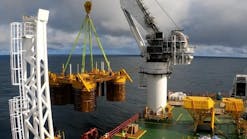The US oil and gas drilling rig count jumped 15 units to 539 during the week ended Oct. 14, according to Baker Hughes Inc. data.
The overall tally of active rigs is now up 135 units since May 27. Compared with the count for the week ended Dec. 5, 2014, just before the drilling dive commenced following the initial plunge in crude-oil prices, the overall tally is down 1,381 units.
In a departure from the usual oil-directed, Permian-bolstered increase during the rebound, this week’s rise largely reflects additions in gas-directed rigs spread across a few shale plays. Their 11-unit jump to 105 represents their biggest weekly gain in nearly 2 years. Until this week, the gas-directed count had stayed within a range of 81-94 since Mar. 11.
Nevertheless, the oil-directed count recorded its 18th increase of the past 20 weeks, gaining 4 units to 432 (OGJ Online, Oct. 7, 2016). Since the week ended May 27, rigs targeting oil have increased 116 units.
The growing rig count has resulted in shrinking declines and upward revisions in well count and production data. The American Petroleum Institute estimate of oil wells drilled and completed during the third quarter fell just 3.7% from the second quarter total to 2,285. Over the past year and a half, the quarterly drop has averaged 17.3%.
In its October Short-Term Energy Outlook, meanwhile, the US Energy Information Administration revised upward its US crude oil production forecast for 2017 by 100,000 b/d to 8.6 million b/d (OGJ Online, Oct. 13, 2016). The revision reflects changes in EIA’s modeling methodology applied to the Lower 48.
“Most important in the new methodology, all horizontal wells drilled since 2014 are fit with individual decline curves and projected out to 2020 before being aggregated to state and sub-state region levels,” EIA explained. “Aggregate decline curve parameters are also calculated for all other wells by states and intrastate regions.”
EIA expects US crude output to average 8.7 million b/d this year compared with 9.4 million b/d last year. During the week ended Oct. 7, US crude output averaged 8.45 million b/d, down 17,000 b/d from the previous week’s average and 646,000 b/d year-over-year, EIA separately reported. A 36,000-b/d drop from the Lower 48 was more than halved by a 19,000-b/d gain in Alaska.
Louisiana, Oklahoma lead gains
Land-based rigs added 13 units this week to total 513. The count of rigs engaged in horizontal drilling posted its largest increase in more than 2 years, jumping 18 units to 431, up 117 since May 29. The horizontal tally peaked at 1,372 on Nov. 21, 2014. Directional drilling rigs, meanwhile, edged up a unit to 51.
Two more rigs began drilling in inland waters, bringing that count to 3 while helping Louisiana lead the major oil- and gas-producing states with a 6-unit rise to 48. The Haynesville also rose 2 units and now totals 16.
Oklahoma and New Mexico each gained 3 units to 73 and 48, respectively. Oklahoma has added 19 units since June 24, reflecting in part a mobilization of rigs to the Cana Woodford. The play jumped 4 units this week to 39 and has added 15 units since Oklahoma’s rebound began. The Mississippian lost a unit this week to 2.
Colorado and its DJ-Niobrara increased 2 units to 21 and 18, respectively.
Pennsylvania, West Virginia, and Alaska each rose a unit to respective totals of 25, 10, and 9. Pennsylvania’s count has nearly doubled since July 8. The Marcellus, up 2 units this week to 34, has added 13 units since Aug. 12.
Down 3 units to 244, Texas was the only state to record a loss. The Eagle Ford dropped 4 units to 31, just 2 units above its bottom reached in late May and early June. The Permian count decreased 2 units to 201 and has remained relatively stagnant since Sept. 2.
Given the slowing of upward drilling momentum in the state over the past several weeks, petroleum economist Karr Ingham says he expects rig-count growth in Texas to stall in the near future without the support of another oil-price increase (OGJ Online, Oct. 7, 2016).
However, more rigs could be in store for the Permian, at least, over the next several months. In the Delaware basin in particular, firms continue to snatch up acreage and add rigs.
The latest deal is RSP Permian Inc.’s acquisitions of Silver Hill Energy Partners LLC and Silver Hill E&P II LLC for $2.4 billion (OGJ Online, Oct. 14, 2016). RSP Permian said it subsequently plans to add a third operated horizontal rig during second-quarter 2017 and a fourth in fourth-quarter 2017 on its newly acquired properties.
The firm also expects to add a fourth operated horizontal rig on its Midland basin properties during second-quarter 2017, bringing the company total in the Permian to 8 horizontal rigs working by yearend 2017.
Fellow Permian operator Diamondback Energy Inc., previously said to be interested in acquiring Silver Hill, this week reported plans to add a fifth rig to its acreage in the coming weeks and a sixth early next year.
Contact Matt Zborowski at [email protected].
